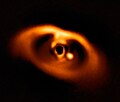
A sub-brown dwarf or planetary-mass brown dwarf is an astronomical object that formed in the same manner as stars and brown dwarfs (i.e. through the collapse of a gas cloud) but that has a planetary mass, therefore by definition below the limiting mass for thermonuclear fusion of deuterium (about 13 MJ). [1] Some researchers include them in the category of rogue planets [2] whereas others call them planetary-mass brown dwarfs. [3]

